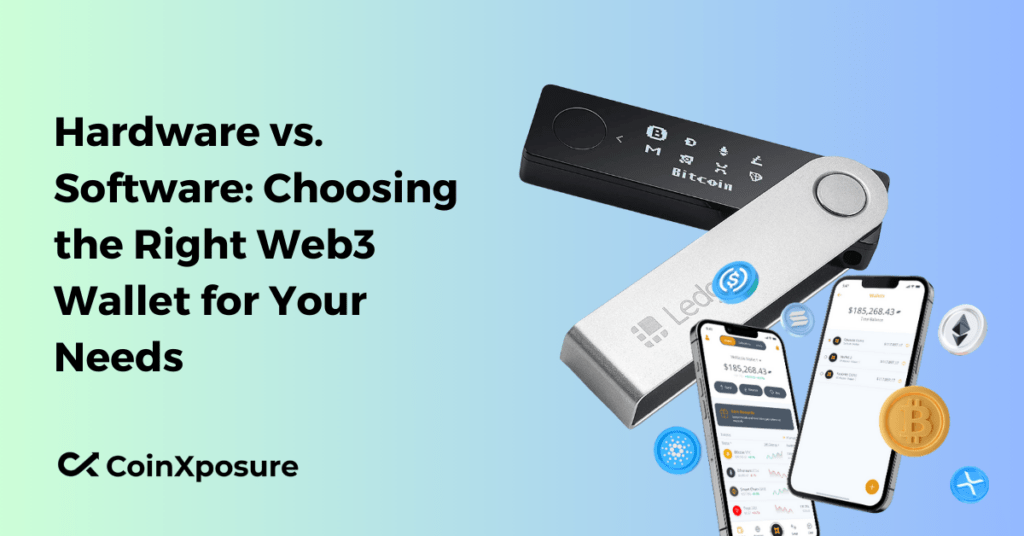In the evolving landscape of decentralized finance (DeFi) and blockchain technology, Web3 wallets are crucial in securely managing digital assets and interacting with decentralized applications (dApps).
When selecting the most suitable wallet, users often decide between hardware and software options.
This choice hinges on various factors, including security, usability, and personal preferences.
Understanding the distinctions between Web3 wallet – hardware and software wallets is paramount in making an informed decision that aligns with one’s needs and priorities in the Web3 ecosystem.
Understanding Hardware Wallets
Hardware wallets are physical devices designed to securely store cryptocurrency keys offline, offering a robust solution for safeguarding digital assets. Here’s a breakdown of their key features:
- Security
- Offline Storage
- Physical Authentication
- Encryption
- Compatibility
Security
Hardware wallets provide high levels of security by keeping private keys isolated from internet-connected devices, thus protecting against online threats like hacking and phishing attacks.
Offline Storage
Since hardware wallets store private keys offline, they are immune to online vulnerabilities, such as malware and viruses, making them an ideal choice for long-term storage of cryptocurrencies.
Physical Authentication
Most hardware wallets require physical authentication, such as pressing buttons or entering a PIN code, to authorize transactions. This adds an extra layer of security, preventing unauthorized access even if the device is stolen.
Encryption
Private keys stored on hardware wallets are typically encrypted, further enhancing security and ensuring that even if the device is compromised, the keys remain protected.
Compatibility
Hardware wallets are compatible with a wide range of cryptocurrencies and blockchain networks, allowing users to securely store and manage multiple digital assets from a single device.
Hardware wallets offer unparalleled security and peace of mind for cryptocurrency holders, making them an essential tool for anyone looking to protect their investments in the rapidly evolving world of blockchain technology.
Exploring Software Wallets
Software wallets, also known as hot wallets, are applications or software programs that securely store cryptocurrency keys on internet-connected devices like computers, smartphones, or tablets. Here’s an overview of their features:
- Accessibility
- Convenience for Transactions
- Variety of Options
- User Interface
Accessibility
Software wallets are highly accessible, allowing users to easily download and install them on various devices. They offer the convenience of accessing funds from anywhere with an internet connection.
Convenience for Transactions
Software wallets are ideal for frequent transactions, as they provide quick and easy access to funds for sending and receiving cryptocurrencies. They are commonly used for day-to-day spending and trading activities.
Variety of Options
There is a wide variety of software wallets available, ranging from desktop applications to mobile apps and web-based wallets. Users have the flexibility to choose a wallet that best suits their preferences and device compatibility.
User Interface
Software wallets typically offer user-friendly interfaces, making them accessible to both novice and experienced cryptocurrency users. They often include features such as transaction history, balance tracking, and QR code scanning for seamless transactions.
Software wallets offer convenience and accessibility for everyday cryptocurrency transactions but require users to be vigilant about security practices to protect their funds from online threats.
Factors to Consider in Choosing a Web3 Wallet
When choosing a Web3 wallet, several factors should be considered to ensure it aligns with your needs and priorities in managing digital assets and interacting with decentralized applications (dApps). Here are key factors to consider:
- Security
- Usability
- Supported Assets
- Compatibility
Security
Evaluate the security features of the wallet, including encryption, multi-factor authentication, and backup options.
Consider whether the wallet employs industry-standard security measures to protect your private keys and funds from unauthorized access and cyber attacks.
Usability
Assess the user interface and overall usability of the wallet. Look for intuitive navigation, easy account management, and seamless integration with dApps and decentralized exchanges (DEXs).
Consider whether the wallet meets your preferences in terms of accessibility and convenience for conducting transactions.
Supported Assets
Check which cryptocurrencies and blockchain networks are supported by the wallet.
Ensure it supports the assets you intend to store and transact with, as well as any specific features or functionalities required for interacting with particular dApps or protocols.
Compatibility
Consider the compatibility of the wallet with different devices and operating systems.
Determine whether it supports desktop computers, mobile devices, or web browsers, and whether it is compatible with your preferred platform (e.g., Windows, macOS, iOS, Android).
By considering these factors, you can make an informed decision and choose a Web3 wallet that best meets your security, usability, and functionality requirements for managing and interacting with digital assets in the decentralized ecosystem.
Conclusion
Choosing the right Web3 wallet is a critical decision that requires careful consideration of several key factors.
Security should be paramount, with robust encryption, multi-factor authentication, and backup options to safeguard your private keys and digital assets from unauthorized access and cyber threats.
Usability is also essential, as the wallet should offer an intuitive user interface and seamless integration with decentralized applications (dApps) and exchanges for convenient transactions and account management.
Compatibility with different devices and operating systems ensures accessibility across various platforms, while support for a wide range of cryptocurrencies and blockchain networks enables flexibility in managing diverse digital assets.
Additionally, considering the reputation of the wallet provider, ongoing development activity, and community feedback can help gauge the reliability, support, and trustworthiness of the wallet over time.
By carefully evaluating these factors and prioritizing your security, usability, and functionality requirements, you can select a Web3 wallet that aligns with your needs and preferences, empowering you to securely manage and interact with digital assets in the decentralized ecosystem.
